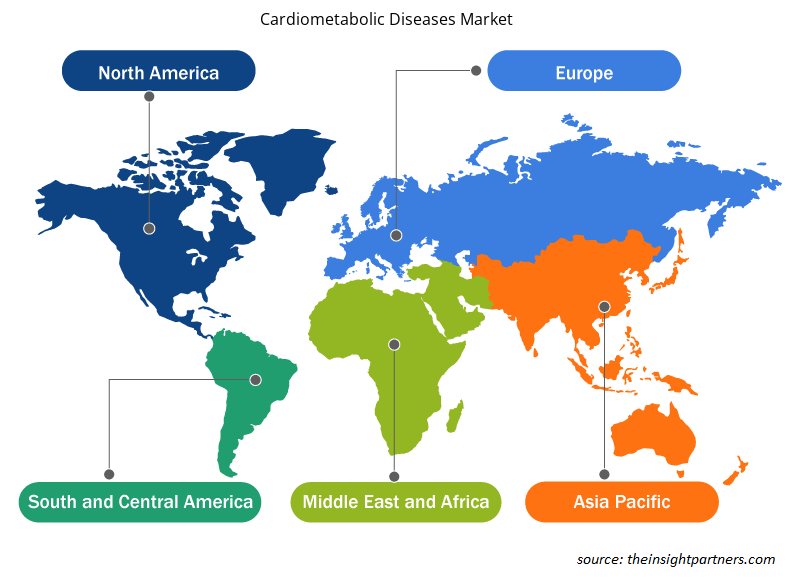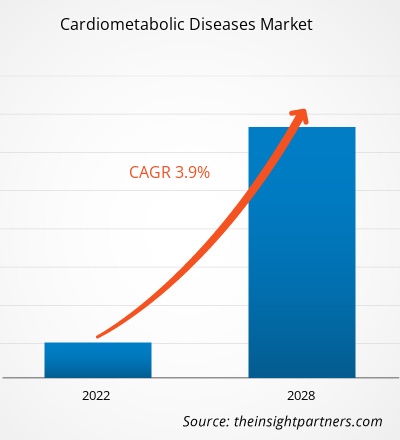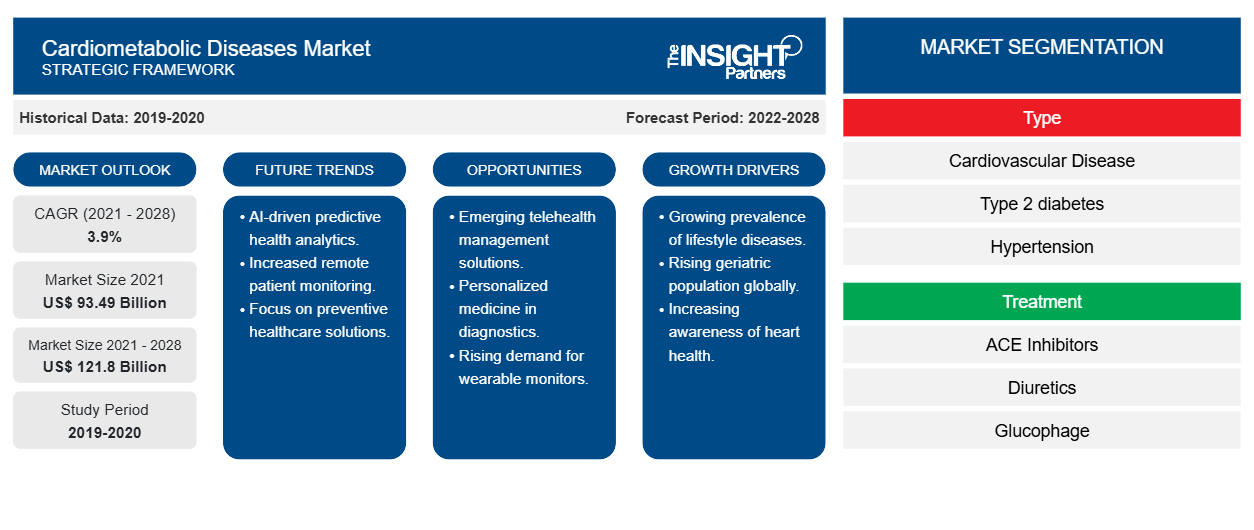Si prevede che il mercato delle malattie cardiometaboliche raggiungerà i 121.804,49 milioni di dollari entro il 2028, rispetto ai 93.494,41 milioni di dollari del 2021; si stima che crescerà a un CAGR del 3,9% nel periodo 2021-2028.
La malattia cardiometabolica è caratterizzata da un gruppo di anomalie e sintomi che aumentano il rischio di sviluppare malattie cardiovascolari. Ipertensione, obesità, resistenza all'insulina, dislipidemia, basso profilo di colesterolo (LDL) e tolleranza al glucosio sono alcuni sintomi delle malattie cardiometaboliche. Gli individui che soffrono di sindrome cardiometabolica sono inclini a molte altre malattie pericolose per la vita, come diabete di tipo 2, ictus, malattia coronarica (CAD) e malattie cardiovascolari (CVD). Sia le condizioni genetiche che quelle ambientali sono responsabili dello sviluppo delle malattie.
La crescita del mercato delle malattie cardiometaboliche è attribuita principalmente a fattori quali la crescente prevalenza delle malattie cardiometaboliche e l'innovazione nelle terapie per le CMD. Tuttavia, la sottodiagnosi delle CVD nei paesi a basso e medio reddito (LMIC) sta ostacolando la crescita del mercato.
Personalizza questo report in base alle tue esigenze
Riceverai la personalizzazione gratuita di qualsiasi report, comprese parti di questo report, o analisi a livello nazionale, pacchetto dati Excel, oltre a usufruire di grandi offerte e sconti per start-up e università
-
Scopri le principali tendenze di mercato in questo rapporto.Questo campione GRATUITO includerà analisi di dati che spaziano dalle tendenze di mercato alle stime e alle previsioni.
Approfondimenti di mercato
Aumento della prevalenza delle malattie cardiometaboliche
Le malattie cardiometaboliche (CMD) sono una delle principali cause di morte in tutto il mondo. Queste malattie sono causate principalmente da uno stile di vita non sano, inattività fisica, fumo e una dieta non sana. Le CMD includono malattie cardiovascolari (CVD), diabete mellito e insufficienza renale cronica. Secondo l'OMS, circa 17,9 milioni di persone sono morte per CVD nel 2019, rappresentando il 32% di tutti i decessi globali. Di questi decessi, l'85% è stato dovuto ad infarto e ictus.
La maggior parte delle malattie cardiovascolari può essere prevenuta affrontando i fattori di rischio comportamentali, come l'assunzione di tabacco, scelte alimentari non sane, obesità, inattività fisica e consumo di alcol. Il diabete è una delle malattie croniche pericolose per la vita senza cura funzionale. Porta a varie complicazioni e aumenta il rischio complessivo di morte prematura. Infarto, ictus, insufficienza renale, amputazione delle gambe, perdita della vista e danni ai nervi sono le principali complicazioni associate al diabete. Secondo l'International Diabetes Federation (IDF), nel 2019, circa 463 milioni di adulti vivevano con il diabete, che dovrebbe raggiungere i 700 milioni entro il 2045.
C'è un aumento globale del numero di persone con una o più CMD a causa del fumo crescente, della mancanza di esercizio fisico, del consumo di alcol e delle cattive abitudini alimentari. Secondo le statistiche dell'OMS di luglio 2021, più di 8 milioni di persone muoiono ogni anno a causa del consumo di tabacco. Il suo consumo è più elevato nei paesi a basso e medio reddito, con l'80% della sua base di consumatori globali che vive in questi paesi. La crescente prevalenza dell'obesità sta dando origine anche alla base di pazienti che soffre di CMD. Con questa rapida crescita della prevalenza di CMD, la necessità di trattamenti appropriati per le malattie cardiometaboliche è salita alle stelle, con conseguente enorme crescita del mercato.
Informazioni basate sul tipo
Il mercato delle malattie cardiometaboliche, per tipo, è segmentato in malattie cardiovascolari (CVD), ipertensione, diabete di tipo 2 e obesità. Il segmento delle malattie cardiovascolari (CVD) ha detenuto la quota maggiore del mercato nel 2021 e si prevede che il segmento registrerà il CAGR più elevato nel mercato durante il periodo di previsione.
Approfondimenti basati sul trattamento
In base al trattamento, il mercato delle malattie cardiometaboliche è segmentato in ACE inibitori, diuretici, Glucophage e altri. Il segmento degli ACE inibitori ha detenuto la quota maggiore del mercato nel 2021 e si prevede che lo stesso segmento registrerà il CAGR più elevato nel mercato durante il periodo di previsione.
Approfondimenti basati sul dosaggio
Il mercato delle malattie cardiometaboliche, in base al dosaggio, è diviso in compresse e iniezioni. Il segmento delle compresse ha detenuto una quota di mercato maggiore nel 2021 e si prevede che registrerà un CAGR più elevato nel mercato durante il periodo di previsione.
Approfondimenti basati sulla via di somministrazione
Il mercato delle malattie cardiometaboliche, per via di somministrazione, è diviso in orale e intravenoso. Nel 2021, il segmento orale ha detenuto una quota maggiore del mercato e si prevede che registrerà un CAGR più elevato nei prossimi anni.
Informazioni basate sugli utenti finali
Il mercato delle malattie cardiometaboliche, per utenti finali, è segmentato in clinica, ospedale e assistenza domiciliare. Nel 2021, il segmento ospedaliero ha detenuto la quota maggiore del mercato e si prevede che registrerà il CAGR più elevato nel mercato durante il periodo di previsione.
I lanci e le approvazioni di prodotti sono strategie comunemente adottate dalle aziende per espandere la loro presenza globale e i loro portafogli di prodotti. Inoltre, i test di mercato sviluppati in laboratorio si concentrano sulla strategia di partnership per ampliare la loro clientela, il che, a sua volta, consente loro di mantenere il loro marchio a livello globale.
Il rapporto suddivide il mercato delle malattie cardiometaboliche come segue
In base al tipo, il mercato delle malattie cardiometaboliche è segmentato in malattie cardiovascolari (CVD), ipertensione, diabete di tipo 2 e obesità. In base al trattamento, il mercato è segmentato in ACE inibitori, diuretici, Glucophage e altri. In base al dosaggio, il mercato delle malattie cardiometaboliche è suddiviso in compresse e iniezioni. In base alla via di somministrazione, il mercato è suddiviso in orale e endovenosa. In base agli utenti finali, il mercato delle malattie cardiometaboliche è segmentato in clinica, ospedale e assistenza domiciliare. In base alla geografia, il mercato è segmentato in Nord America (Stati Uniti, Canada e Messico), Europa (Regno Unito, Germania, Francia, Italia, Spagna e resto d'Europa), Asia Pacifico (Cina, Giappone, India, Australia, Corea del Sud e resto dell'Asia Pacifico), Medio Oriente e Africa (Emirati Arabi Uniti, Arabia Saudita, Sud Africa e resto del Medio Oriente e Africa) e America meridionale e centrale (Brasile, Argentina e resto dell'America meridionale e centrale).
Approfondimenti regionali sul mercato delle malattie cardiometaboliche
Le tendenze regionali e i fattori che influenzano il mercato delle malattie cardiometaboliche durante il periodo di previsione sono stati ampiamente spiegati dagli analisti di Insight Partners. Questa sezione discute anche i segmenti e la geografia del mercato delle malattie cardiometaboliche in Nord America, Europa, Asia Pacifico, Medio Oriente e Africa e America meridionale e centrale.

- Ottieni i dati specifici regionali per il mercato delle malattie cardiometaboliche
Ambito del rapporto di mercato sulle malattie cardiometaboliche
| Attributo del report | Dettagli |
|---|---|
| Dimensioni del mercato nel 2021 | 93,49 miliardi di dollari USA |
| Dimensioni del mercato entro il 2028 | 121,8 miliardi di dollari USA |
| CAGR globale (2021 - 2028) | 3,9% |
| Dati storici | 2019-2020 |
| Periodo di previsione | 2022-2028 |
| Segmenti coperti |
Per tipo
|
| Regioni e Paesi coperti |
America del Nord
|
| Leader di mercato e profili aziendali chiave |
|
Densità degli attori del mercato: comprendere il suo impatto sulle dinamiche aziendali
Il mercato delle malattie cardiometaboliche sta crescendo rapidamente, spinto dalla crescente domanda degli utenti finali dovuta a fattori quali l'evoluzione delle preferenze dei consumatori, i progressi tecnologici e una maggiore consapevolezza dei benefici del prodotto. Con l'aumento della domanda, le aziende stanno ampliando le loro offerte, innovando per soddisfare le esigenze dei consumatori e capitalizzando sulle tendenze emergenti, il che alimenta ulteriormente la crescita del mercato.
La densità degli operatori di mercato si riferisce alla distribuzione di aziende o società che operano in un particolare mercato o settore. Indica quanti concorrenti (operatori di mercato) sono presenti in un dato spazio di mercato in relazione alle sue dimensioni o al valore di mercato totale.
Le principali aziende che operano nel mercato delle malattie cardiometaboliche sono:
- Eli Lilly e la società
- Bayer AG
- Prodotti farmaceutici Arrowhead, Inc.
- Novartis AG
- Boehringer Ingelheim International GmbH
Disclaimer : le aziende elencate sopra non sono classificate secondo un ordine particolare.

- Ottieni una panoramica dei principali attori del mercato delle malattie cardiometaboliche
Profili aziendali
- Eli Lilly e la società
- Bayer AG
- Prodotti farmaceutici Arrowhead, Inc.
- Novartis AG
- Boehringer Ingelheim International GmbH
- Novo Nordisk A/S
- AstraZeneca
- Alnylam Pharmaceuticals, Inc.
- Cardax, Inc
- Società per azioni Kowa Company, Ltd.
- Analisi storica (2 anni), anno base, previsione (7 anni) con CAGR
- Analisi PEST e SWOT
- Valore/volume delle dimensioni del mercato - Globale, Regionale, Nazionale
- Industria e panorama competitivo
- Set di dati Excel
Report recenti
Testimonianze
Motivo dell'acquisto
- Processo decisionale informato
- Comprensione delle dinamiche di mercato
- Analisi competitiva
- Analisi dei clienti
- Previsioni di mercato
- Mitigazione del rischio
- Pianificazione strategica
- Giustificazione degli investimenti
- Identificazione dei mercati emergenti
- Miglioramento delle strategie di marketing
- Aumento dell'efficienza operativa
- Allineamento alle tendenze normative























 Ottieni un campione gratuito per - Mercato delle malattie cardiometaboliche
Ottieni un campione gratuito per - Mercato delle malattie cardiometaboliche